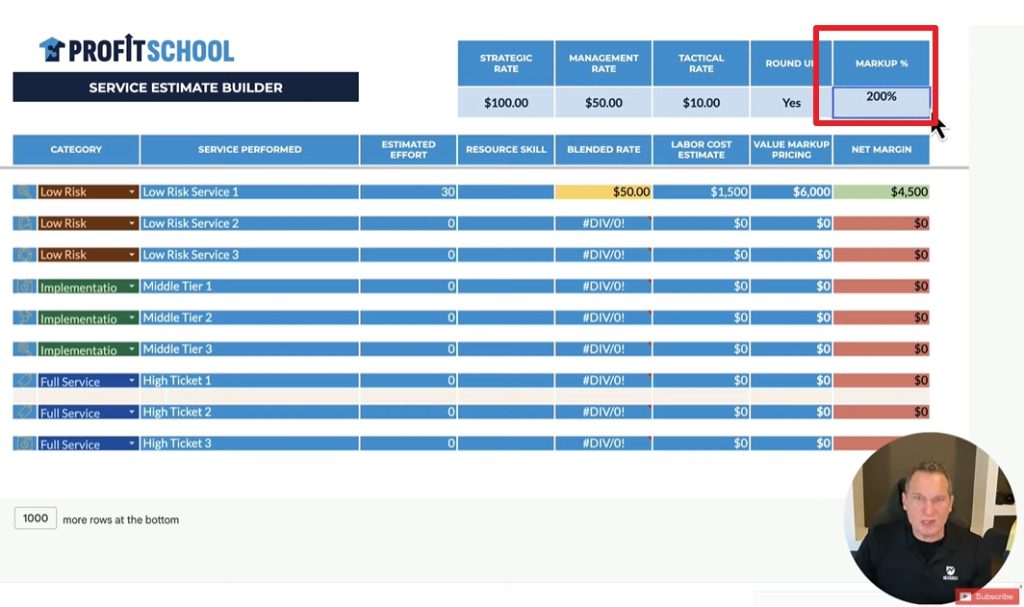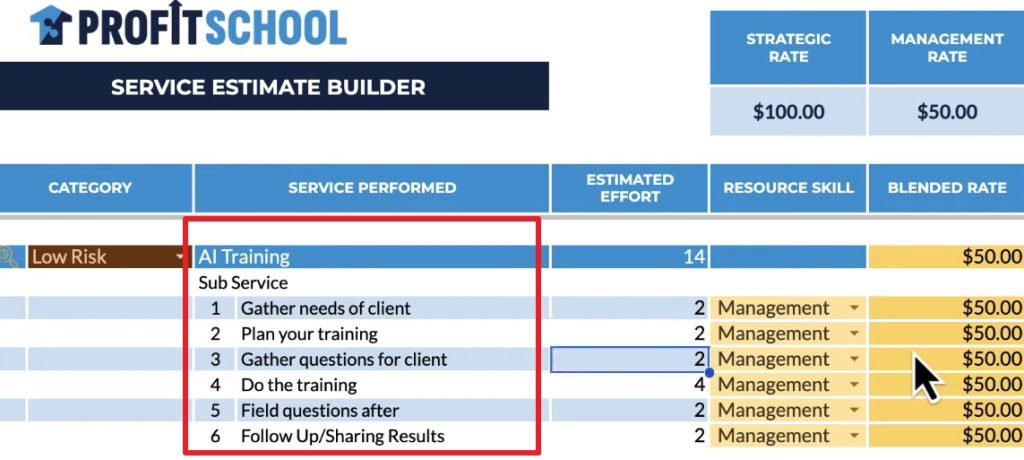How much money have you lost because you never had time to properly set your ideal freelance rate? How many hours will you keep working just to pay yourself, but not your expenses?
I get it. Figuring out freelance rates is tough. And that’s why I'll guide you through a step-by-step process. To make it even easier, I’ll give you access to a free freelance price calculator.
So, take a 10-minute break from fighting your deadlines and finally get your fees right and maximize your income…
Watch the video to ensure you're pricing your freelance services right
In this video, I’ll prevent you from making common pricing mistakes and show you how to use a freelance pricing tool to finally get paid what you deserve.
Key takeaways
- Discover the #1 mistake that's costing you money.
- Follow my step-by-step guide to setting profitable freelance rates.
- Get a free tool to make pricing a breeze.
- Take control of your income and value your work.
- Watch the video to ensure you're pricing your freelance services right
- Key takeaways
- The #1 freelance mistake? Underpricing your services
- Key prep for accurate pricing
- How to calculate my freelance rate? (And get paid what I am worth)
- Don’t make these 4 freelance pricing mistakes
- Common questions and answers about estimating your freelance rates
- What's Your Best Next Step?
The #1 freelance mistake? Underpricing your services
Are you selling yourself short?
Working for less than you're worth is a common issue for freelancers, and it often leads to burnout and unhappiness.
But why does it happen so much? The answer is fear.
Fear of rejection, fear of not getting hired, fear of seeming too expensive.
“Setting your freelance rate is key. It's how you make good money and value your work, but it's something that so many freelancers struggle with.” – Jeff Sauer
Underpricing has serious consequences:
- You earn less.
- Your offerings appear low value.
- Clients see you as cheap labor.
- You attract low-paying clients and struggle to get better ones.
But there's a simple way to overcome this. Use a pricing tool to determine your ideal fees.
It removes the guesswork and ensures you're making money for the quality you deliver.
Before I dive into the details, make sure you do these 3 simple things…
Key prep for accurate pricing
1. Determine your yearly income goal
The first step to setting profitable freelance rates is to figure out your desired annual income.
It might seem like a no-brainer, but many freelancers overlook this.
To set realistic yet ambitious goals, think about what you would do if you made good money from freelancing:
- Reinvest in yourself?
- Reinvest in your business and grow into an agency?
- Acquire tools and resources to streamline your work?
Don’t make it too complicated. You could, for example, want to earn $100,000 a year.
That's your starting point for the next preparation step.
2. Apply the hourly rate formula
Now that you defined your desired annual income, you can easily get to your hourly fee.
This is a crucial step because it forms the foundation for all your pricing decisions.
Here's the basic formula:
(Desired Annual Income) / (Billable Hours Per Year) = Hourly RateA full-time freelancer typically has around 2,000 billable hours in a year. But you can adjust it based on your own schedule and availability.
For example, if you want to earn $100,000 a year and plan to work 2,000 hours, your hourly price would be $50.
Now, it’s time to…
Download the free freelance rate calculator
You'll need the free pricing tool I use in the video.
It's available inside the ProfitSchool Community.
Simply create a free account and head over to your “Resources Toolbox”.

Here you can see a wealth of resources to help you build a sustainable freelancing business.
But remember: we need to get your pricing right before anything else.
How to calculate my freelance rate? (And get paid what I am worth)
Step 1: Factor in markup
Your hourly rate is just the beginning. To run a sustainable freelance business, you need to factor in markup.
Markup is the percentage you add to your hourly rate to cover your business expenses, taxes, and profit.
It ensures that you're not just paying yourself a wage, but also investing in the growth of your business.
In the video I recommend a minimum markup of 200%.
This means that
- for every dollar you pay yourself
- you're charging the client an additional two dollars to cover overhead and profit.
In the pricing tool, you can input your desired markup percentage, and it will automatically adjust your client price accordingly.

For example, if you charge $50 per hour and you apply a 200% markup, your client rate becomes $150 per hour.
Step 2: Create project estimates
Now that you have entered your hourly rate and markup, you can use the tool to create project estimates.
This is where you apply your rate to specific tasks and deliverables. This involves breaking down the project into smaller, manageable tasks and estimating the time required for each.
The tool can help you with this by:
- Allowing you to input the different tasks involved in a project.
- Enabling you to estimate the number of hours for each task.
- Automatically calculating the cost of each task based on your client's hourly rate.
- Providing a total project cost.
For example, if you're providing AI training for companies like I do, you might break it down into tasks like:
- Gathering client needs (2 hours)
- Planning the training (12 hours for a half-day custom training)
- Conducting the training (4 hours for a half-day training)
- Fielding questions after the training (2 hours)
- Following up and sharing results (1 hour}
The pricing tool will then multiply your hourly rate by the estimated hours for each task and sum them up to give you the total project cost.

By using the calculator to create accurate project estimates, you can ensure that you're pricing your projects profitably. Plus, you avoid the common mistake of underestimating the time and effort involved.
Step 3: Adapt your prices
You'll likely need to adapt what you charge based on the specific project and client.
Here's how you can adjust your pricing:
- Reduce your price: You can bring your price down by removing deliverables or reducing the scope of work. This will reduce the time and effort required, allowing you to charge less.
- Provide options: Offer clients different options with varying price points. For example, you could offer a custom training and a standard training, with the standard training being priced lower.
I explain these and other advanced pricing strategies in my free book, Service Stacking. It’s an intuitive sales guide for freelancers like you, who may not like selling, but definitely want to
- close more client deals
- generate higher profit margins
- and turn sales from “random events” into a predictable engine that fuels their business
Don’t make these 4 freelance pricing mistakes
1. Assuming your client wants everything
The biggest mistake you can make is assuming that a client wants everything and then failing to:
- Line item each deliverable.
- Assign value to each deliverable.
- Charge for each deliverable.
By not doing this, you risk undervaluing your work and missing out on potential earnings.
2. Doubting your value
It might seem unethical to charge a high markup, but remember:
The value you provide is worth that amount to the client. – Jeff Sauer
- If they hired someone else, it would cost them at least that much.
- You're running a business and have expenses that employees don't have (health insurance, equipment, etc.).
- The markup allows you to reinvest in your business and grow.
Always prioritize your markup to ensure profitability. It's better to remove deliverables than to reduce your markup.
3. Pulling your prices out of thin air
You need to take several factors into consideration.
First, there is the market demand.
- Is your skill in high demand?
- Are you getting more requests for your services than you can fulfill?
High demand often justifies higher rates.
Your rate isn't just a number, it's about your value, expertise, and meeting market demand.
Next, think about your skill level.
- Are you just starting out?
- Or are you an experienced expert?
Experts can typically charge more due to their greater knowledge and efficiency.
It's also important to research industry standards.
What do other freelancers in your niche charge for similar services?
This gives you a benchmark.
Finally, assess the value you bring to the table.
What unique benefits do you offer clients?
Highlighting your value can help you justify your rates.
Common questions and answers about estimating your freelance rates
How does market demand affect my freelance rates?
Market demand plays a significant role in determining your rates. In a declining industry, you may have to charge less due to lower demand. You might also bill fewer hours. And even your markup might be lower.
If the demand is high, like AI training, you can easily justify higher fees than for training in a saturated market, like MS Office.
Am I charging enough as a freelancer?
The easiest way to know this is by dividing your total earnings by the total hours you worked. This will give you the actual amount you earned per hour. If this is consistently lower than what you should be charging, you need to establish new prices.
What's Your Best Next Step?
You've taken the first step towards pricing your freelance work more effectively. Now, let's keep that momentum going! Here are three ways to continue your journey:
- Download the free rate calculator: If you haven't already, grab it here. (first create a free account)
- Watch it in action: For a clear step-by-step guide, check out my video at the top of the page.
- Level up your freelance business (not just your rates): Grab your free copy of my book Service Stacking. (limited physical copies remaining)
Choose the option that best aligns with your current needs and learning style.
The most important thing is to take action and start valuing your work the way it deserves.
Good luck!
